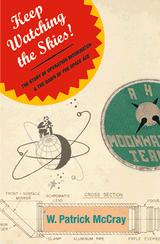
New Book by UCSB Historian Examines Citizen-Scientists and the Dawn of the Space Age

When the Soviets launched the satellite Sputnik in 1957, thousands of people around the world seized the opportunity to become citizen-scientists and take an active part in the dawning space age. Known as Moonwatchers, these teenagers, homemakers, schoolteachers, and otherwise amateur astronomers provided professional astronomers with critical and otherwise unavailable information about the satellite's movement. In a new book published this week titled "Keep Watching the Skies!: The Story of Operation Moonwatch and the Dawn of the Space Age" (Princeton University Press, 2008), W. Patrick McCray, a professor of history at the University of California, Santa Barbara, tells the story of this network of pioneers who participated in what is perhaps the greatest science endeavor of the 20th century.
"Until professionally manned optical tracking stations came online in 1958, the Moonwatchers played a crucial role in providing key information," said McCray. "And even after the optical tracking stations became operational, the Moonwatchers still provided important information."
Established a year before the Sputnik launch, the Operation Moonwatch program was a formal initiative of the Smithsonian Astrophysical Observatory (SAO) located in Cambridge, Mass. Its goal was to enlist the aid of citizen-scientists in the efforts of the observatory's professional astronomers to track the first satellites.
Whether in California, Indiana, New York, or anywhere else in the world where the SAO had established optical tracking stations, Moonwatch teams would use their telescopes to gather data regarding Sputnik's location and transmit their findings to the observatory in Cambridge. Scientists there would compare the Moonwatchers' findings with the predictions calculated by the observatory's computers.
Moonwatching became a serious endeavor, according to McCray, with teams creating their own logos and stationary and holding open houses for people who wanted to learn more about Sputnik and satellites in general. Many team members sported Moonwatch pins provided by Convair, the United States aerospace company that developed and manufactured –– among other missiles, rockets, and aircraft –– the first-generation intercontinental ballistic missile. In addition, Moonwatch teams participated in special practice drills to test their accuracy and efficiency.
"Civil Air Patrol planes would fly over a designated practice area trailing a length of clothesline to which a toilet plunger was attached at the end. A light fixed inside the rubber end of the plunger simulated the appearance of a satellite," said McCray.
Drawing on previously unexamined letters, photos, scrapbooks, and interviews, McCray recreates a pivotal event from a perspective never before examined –– that of ordinary people who jumped at the chance to take part in the excitement of space exploration.
McCray specializes in American science during the Cold War, the history of modern physical science and technology, and the history of early modern craft technologies. He is also a researcher at UCSB's Center for Nanotechnology in Society. He received his Ph.D. from the University of Arizona in 1996. He is the author of the "Giant Telescopes: Astronomical Ambition and the Promise of Technology" (Harvard University Press, 2004) and "Glassmaking in Renaissance Venice: The Fragile Craft" (Ashgate Publishing, 1999). His current research on nanotechnology considers recent developments in nanoelectronics and how new developments in areas such as quantum dots and spintroncs fit into the larger history of the United States electronics industry. In addition, McCray is at work on a new book that examines the history of various exploratory technologies in the 1970's and 80's, including nanotechnology and space exploration.
Related Links



